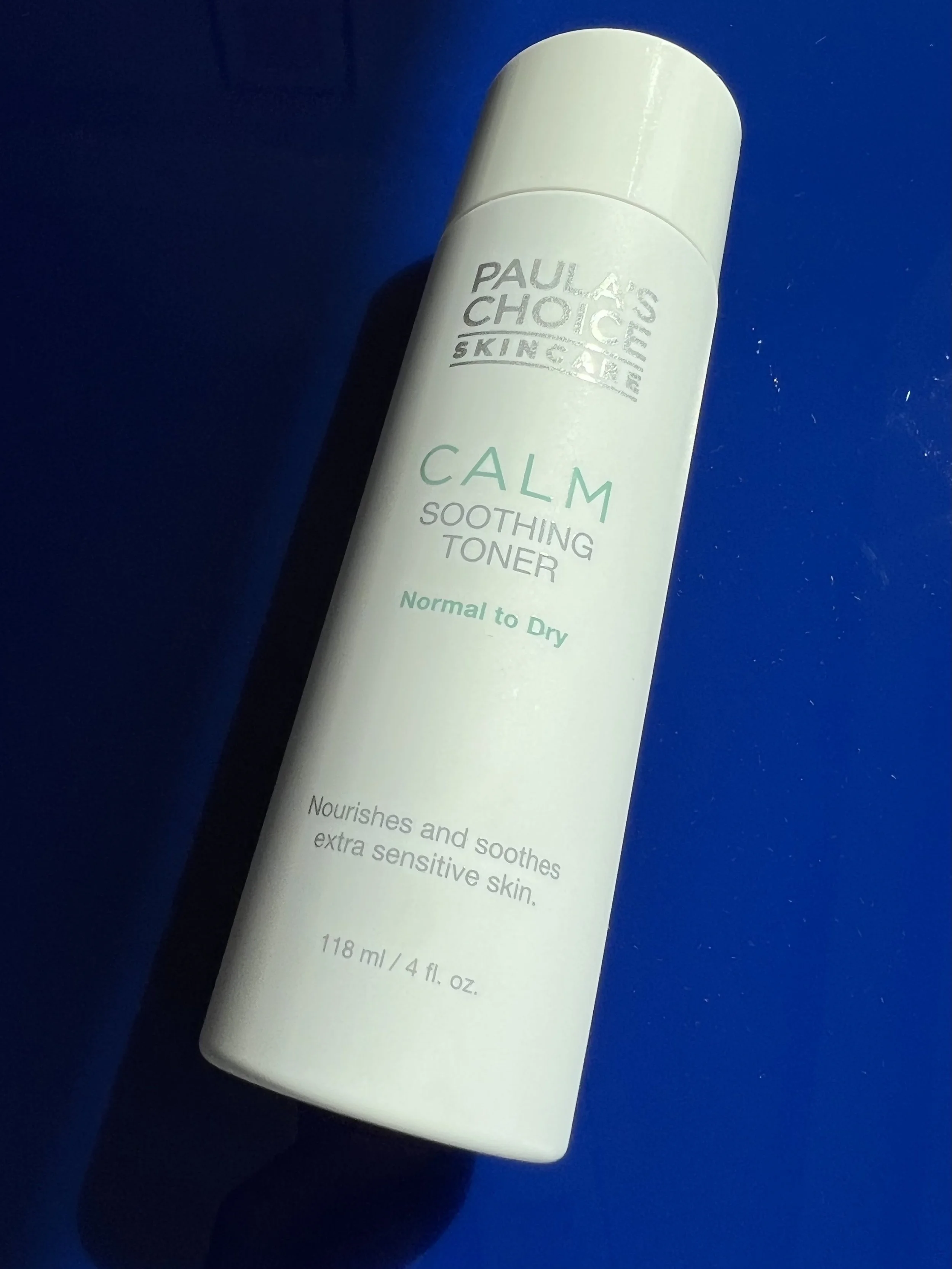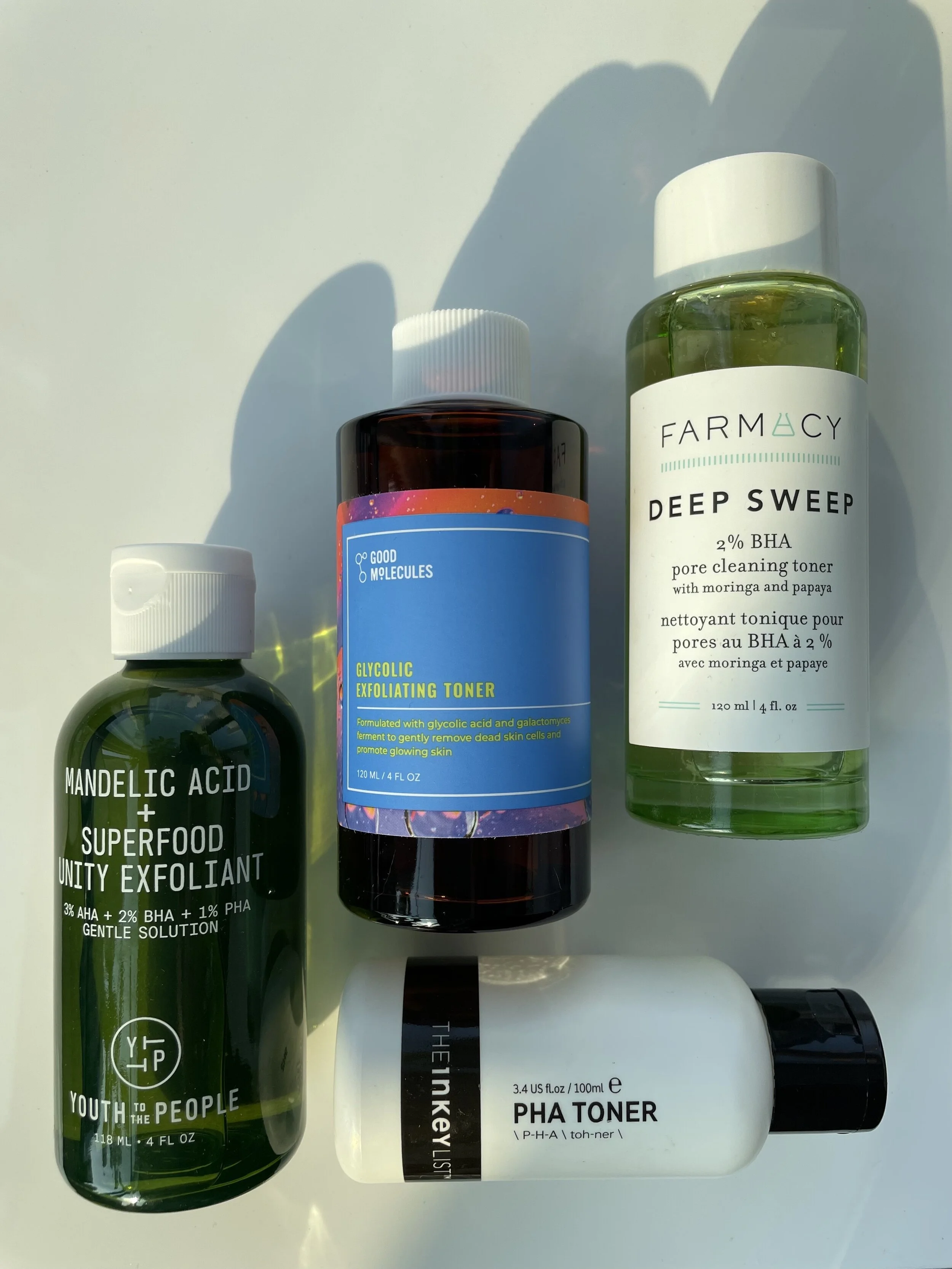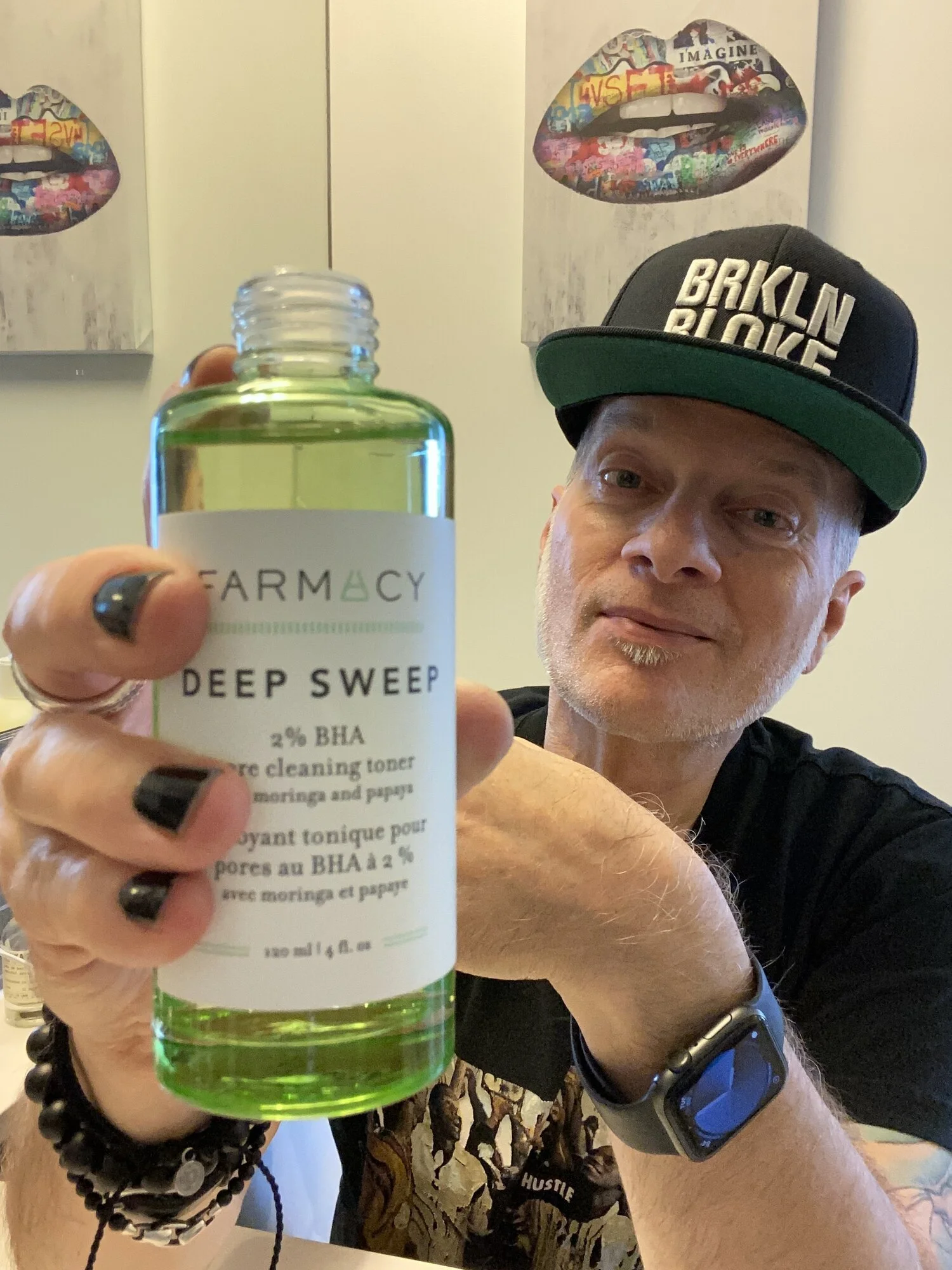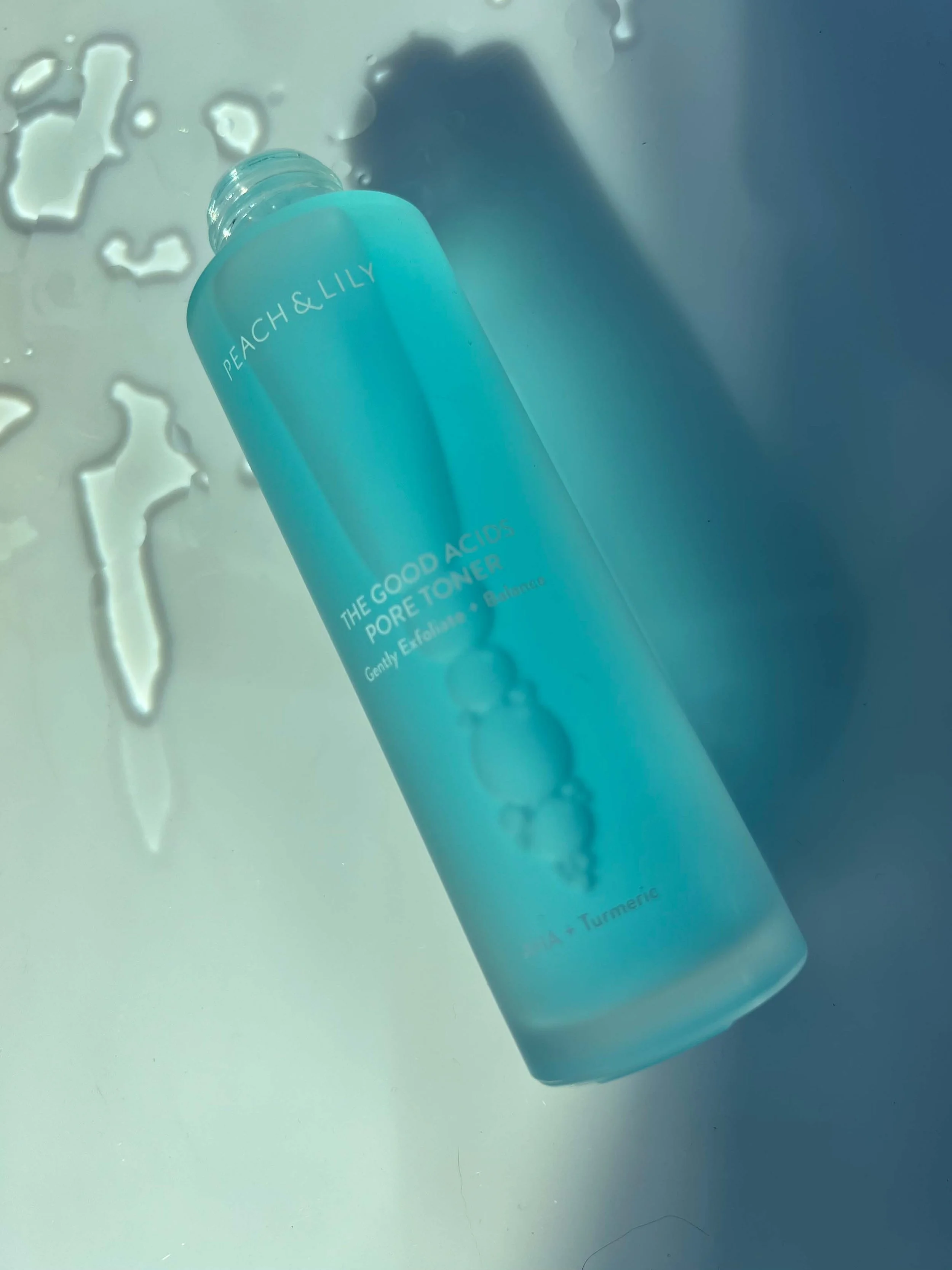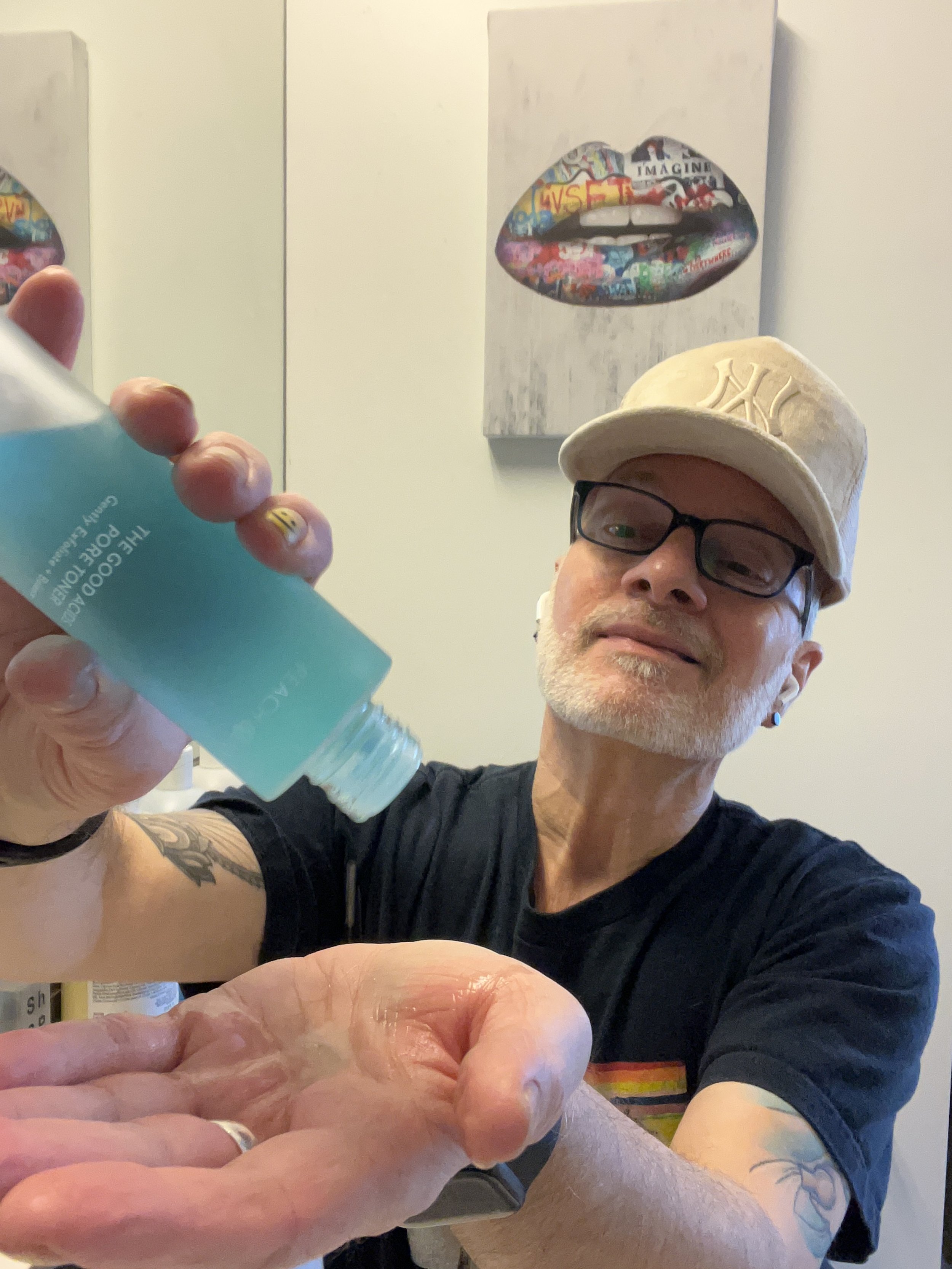PRODUCT REVIEW: PEACH & LILY THE GOOD ACIDS PORE TONER – BEST GENTLE ACID TONER FOR SENSITIVE SKIN , BEST BRIGHTENING TONER, HOW TO FIX DULL SKIN
PEACH & LILY | THE GOOD ACIDS PORE TONER
I haven’t always been into acid-powered treatment toners. But as I’ve gotten older, I find that my complexion gets dull more frequently.
And what’s the best way to fix dull skin? Acids! All kinds of acids can have a significant effect on the skin — instantly and over time.
Alpha hydroxy acids, or AHA’s like Glycolic Acid and Lactic Acid are among the most common for their ability to immediately exfoliate skin of the dead surface skin cells that dull the complexion.
The most common acid for the treatment of oily skin concerns like clogged pores is Salicylic Acid, a beta hydroxy acid, or BHA. If clogged, congested pores and excess surface oil are a concern for you, Salicylic Acid is your BFF.
And a whole class of acids called polyhydroxy acids, or PHA’s, is relatively new to skincare treatments, particularly treatment toners. What acids are PHA’s? Among the most common PHA’s are Gluconolactone and Lactobionic Acid. Like Glycolic Acid and Mandelic Acid, PHA’s like Gluconolactone are efficient exfoliating acids. Unlike their AHA sisters, they are far more gentle on the skin. They’re cropping up in more and more product INCI’s.
One of the best PHA toners is The Inkey List’s PHA Exfoliating Toner. Even though Inkey’s PHA Toner is a simple formula, it has a lot of pro-skin health goodness. It gently exfoliates, brightens, and soothes — and all that for just about $10. It’s excellent for amping up your daily routine. You can catch my review of it on the blog here.
PRODUCT REVIEW: THE INKEY LIST POLYHYDROXY ACID (PHA) GENTLE EXFOLIATING TONER – BEST PHA TONER
When it comes to using a treatment toner powered by AHA’s, BHA’s and PHA’s, the trick is striking the right balance between the level of acids, the frequency of use, and your own skin’s tolerance of strong actives.
In particular, overdoing it with harsh acids is one of the quickest ways to sensitize your skin and leave you in a skincare rut where you struggle with irritation and intolerance of actives like Vitamin C and Retinol.
I’ve been there. Having overdone it with Glycolic Acid treatments at one point, I was suddenly facing inflamed skin with extreme irritation and redness. Even water hurt. For days, I was unable to use anything more on my skin than a gentle cleanser and a face cream for sensitive skin. My skincare break spanned three days, after which my skin had calmed down and I was good to go again.
So, striking the right balance for your skin is essential!
I believe I’ve done just that by moderating my use of acid toners and restricting myself to just a couple of times a week, at most. That also helps me to truly evaluate the differences between really well-formulated treatment toners and, well, the duds.
I think toners are wildly misunderstood. The funny thing about toners is that not all are created equal — or do the same thing. When talking about treatment toners specifically, I always feel the need to make the distinction between acid-powered treatment toners and hydrating toners. The two are not mutually exclusive; that is, you don’t use one or the other. While they’re both called toners, they have completely distinct purposes and benefits for the skin. And contrary to what many think about them, I firmly believe toners are essential to a pro-skin health skincare routine.
After cleansing AM and PM, I alternate between a hydrating toner and a more active treatment toner in my skincare routines — and often use one of each, one after the other. In fact, it is not uncommon for me to use three different toners in a routine: an antioxidant toning mist, a hydrating toner, and a treatment toner powered by an exfoliating acid.
My all-time favorite toner is actually an antioxidant toning mist, the NIOD Superoxide Dismutase Saccharide Mist (SDSM2). In fact, SDSM2 is one of the first skincare products I use each morning in what could best be described as my pre-morning skincare routine. I wake up, feed Orpheus, wash my face, and mist on NIOD’s SDSM2. It’s tantamount to taking my morning vitamins! You can catch my review of it on the blog here.
PRODUCT REVIEW: NIOD SUPEROXIDE DISMUTASE SACCHARIDE MIST (SDSM2) - BEST ANTIOXIDANT TONER
Every skincare routine, morning and evening, should consist of a hydrating toner — applied immediately following cleansing. Hydration is a must for skin health and IMO essential to a robust and healthy skincare regimen. It saddens me when I hear people say they skip a toner, or don’t understand why it’s important. A hydrating toner does just that: it hydrates the skin. And optimally hydrated skin is optimally healthy skin!
Among my favorite hydrating toners is the Paula’s Choice Redness Relief Toner — perhaps the best hydrating toner I’ve come across. It’s also the best toner for sensitive skin and indispensable to anyone who struggles with sensitivity of any kind.
But it’s great for all skin types! The silky formula contains a powerful complex of soothing botanical extracts that combine for a high concentration of skin soothers to calm irritated skin. The Redness Relief Toner is part of the brand’s Calm collection — products formulated specifically for the treatment of redness and irritation.
PRODUCT REVIEW: PAULA’S CHOICE CALM REDNESS RELIEF REDNESS RELIEF TONER - BEST TONER FOR SENSITIVE SKIN
Unlike a hydrating toner, a treatment toner, on the other hand, is formulated with beneficial exfoliating acids — usually one or more actives from the class of hydroxy acids — AHA’s, BHA’s or PHA’s. After applying a hydrating toner, if you want to use a treatment toner to exfoliate your skin, brighten your complexion and and boost your skin’s “desquamation” process, you can (and should!).
My latest deep-dive into acid-powered treatment toners came last fall in an article titled, Seasonal Skincare Transitioning: Treatment Toners I Love That Make Me Excited For Cold Weather. In the piece, I featured some of the best exfoliating toners with Glycolic Acid, Salicylic Acid and even Mandelic Acid.
You can catch the full article here.
SEASONAL SKINCARE TRANSITIONING: TREATMENT TONERS I LOVE THAT MAKE ME EXCITED FOR COLD WEATHER
What Does Desquamation Mean and Why Does Desquamation Occur?
In short, desquamation is a term that encompasses cell regeneration, cell death and surface exfoliation. More specifically, desquamation is the process by which the skin generates new skin cells and, 28 days or so later, sheds them. Desquamation essentially encompasses the life cycle of a skin cell. A treatment toner formulated with an alpha hydroxy acid like Glycolic Acid can, if formulated properly and at the precise pH level, amplify the cell turnover process.
There’s an excellent, insightful piece on the Very Well Health website titled, Desquamation Process and the Outer Layer of Skin. According to the health site Very Well Health:
Desquamation is the natural process in which skin cells are created, sloughed away, and replaced. The desquamation process happens in the outermost layer of the skin called the epidermis. The epidermis itself has four unique layers. Each of these layers plays a role in desquamation.
Skin Cells are Born
Sometimes called cell turnover, desquamation happens every second of the day, without you even noticing.
New skin cells are created in the stratum germinativum, which is the deepest layer of the epidermis. This layer is also called the basal layer.
Skin cells begin their life as a single layer of thick, column-shaped cells. These cells are responsible for creating every cell of your skin.
The cells in this layer divide. Half of them stay behind in the stratum germinativum. The other cells begin their migration to the skin's surface.
Cells Reach the Surface, Then Slough Off
The skin cells have reached their final destination — the stratum corneum. Once the cells arrive at this uppermost layer of the skin they are essentially dead.
The cells in the stratum corneum are very flat and tightly packed. These flat, dead cells continuously fall away as newer cells push their way to the surface. In this way, your skin is constantly renewing itself.
Where do all of those dead skin cells go? You might be surprised to know that most of the dust in your home is actually made up of dead skin cells.
The entire desquamation process, from cell birth to sloughing away, takes approximately 14 to 28 days.
PRODUCT REVIEW: FARMACY DEEP SWEEP 2% BHA PORE CLEANING TONER – BEST SALICYLIC ACID TONER FOR OILY SKIN
One of my favorite acid toners of 2021 was the Farmacy Deep Sweep 2% BHA Pore Cleaning Toner with Moringa + Papaya. As far as exfoliating toners go, the Deep Sweep 2% BHA Pore Cleaning Toner is a good, clean formula and among the best Salicylic Acid treatments for face. It’s a safe-for-skin, refreshing, effective treatment toner and a pleasure to use.
As I said in my initial review of it, I’ve been quite impressed by Farmacy’s Deep Sweep BHA toner and really appreciate the pro-skin health approach, making it useful for all skin types, not just those with oily, acne-prone skin who benefit most from Salicylic Acid.
Which brings me to my latest recommendations of the best treatment toners!
The Cocokind Turmeric Illuminating Solution is the latest product introduction from one of my favorite brand discoveries of 2022. I’m a huge fan of Turmeric Root Extract in skincare and can’t get enough of this stuff!
Algenist’s GENIUS Liquid Skin Resurfacing 2% BHA Toner is one of the most unique treatment toners that I’ve ever come across. It’s like a bottle of skin health with multiple potent actives and superb anti-aging benefits for the skin.
And from one of my favorite K-beauty brands, the Peach & Lily The Good Acids Pore Toner, is among the coolest offerings from the brand, known for their focus on “glass skin”. (More on that below!) This toner is a real pleasure to use and gentle enough for daily use.
Let’s have a look at one of the best treatment toners of SS22…
Peach & Lily | The Good Acids Pore Toner
Did someone say glass skin? If the concept sounds bizarre to you, well, it is to me too. You may be familiar with the K-beauty trend toward skin that’s allegedly as smooth and reflective as glass. To be honest, I’m not even sure glass skin is a trend any more. It’s been around for so long, it’s just kind of ingrained into the whole concept of K-beauty.
Brands like Glow Recipe and Peach & Lily were pioneers in introducing American consumers to concepts like the 7-Skin Method and “glass skin.” In fact, my introduction to K-beauty came through both brands with innovative products and wild skincare tips that helped me step up my game in pursuit of what the Koreans call yuri pibu, or the coveted “glass skin”.
Glass skin is the holy grail of K-Beauty!
What is glass skin? Well, it’s hyper-reflectivity, the brightest, smoothest and most radiant your skin can be – and apparently what you should aspire to if you’re putting the time, money and effort into a great skincare routine. It’s so appealing that Peach & Lily introduced an entire collection of skincare called Glass Skin, including the cult favorite Peach & Lily Glass Skin Refining Serum.
And Peach & Lily’s The Good Acids Pore Toner is the first step on your journey to the most reflective skin of your life. As with other common treatment toners, The Good Acids Pore Toner is powered by a blend of exfoliating acids. In the Peach & Lily formula, they’ve included a combination of Glycolic Acid and Salicylic Acid, though they’re at more broadly tolerable concentrations than similar acid toners.
By my estimate, the concentration of Glycolic Acid is at about 5%; the level of Salicylic Acid at less than 2%, more likely one percent. However, what I love is the very high concentration of brightening antioxidant, Turmeric Root Extract – at perhaps 8-10% of the formula. The combination makes for a well-tolerated treatment for regular, even daily use.
What Is Glycolic Acid and What Does Glycolic Acid Do to Your Face?
Glycolic Acid is the strongest, most potent and effective of the range of alpha hydroxy acids, or AHA’s. At concentrations of 10% or more, it can instantly brighten the skin by dissolving the bonds between dead skin cells and the skin surface. Loosening and sloughing off dead skin cells effectively brightens the complexion by leaving fresher, newer cells behind.
There is an insightful article from the experts on the Paula’s Choice Research Team titled, Glycolic Acid: What It Is and Why You Should Use It. In it, the experts expound on the many superb benefits of Glycolic Acid for the skin.
Glycolic Acid Benefits
Using an exfoliant with glycolic acid for your face results in a brighter, more even toned complexion. Like all AHAs, glycolic acid works by helping turn over spent cells on skin’s surface.
This type of exfoliation addresses numerous skin concerns, including sun damage, uneven tone, rough, flaky patches of skin, fine lines, and wrinkles. In higher concentrations, glycolic acid can even improve the look of deeper wrinkles.
Studies also show that glycolic acid significantly increases skin’s hydration. It does this by helping skin make substances like mucopolysaccharides, which help skin stay hydrated by increasing its natural content of hyaluronic acid, which in turn enhances skin’s resilience.
One exciting new note about glycolic acid: emerging research shows it might even protect skin against UV damage (in addition to reducing its damaging after-effects), though more studies need to be done and of course it doesn’t replace the need for sunscreen. Still, it’s a promising development!
Glycolic acid occurs naturally in sugar cane, but is most effective when synthesized in a lab, where its potency and concentration are optimized for use in skin care. Using plant sugars, like sugar maple, for their glycolic acid content is an option, but the bulk of the research on glycolic acid’s benefits for skin is about the synthetic form, because this type can be optimized for effectiveness, purity, stability, and pH, all critical to getting effective glycolic acid products.
Originally a wild-harvested Mediterranean plant, blue tansy — which is actually yellow in color — is now cultivated mainly in Morocco. When the flower’s popularity in beauty products surged, it was harvested almost out of existence in the wild. Today, supplies are steadily increasing, but it’s still one of the more expensive essential oils. A 2-ounce bottle may cost more than $100.
The blooms of Tanacetum annuum are yellow. Its slender leaves are covered with a fine white “fur.” The oil has a sweet, herbal fragrance due to its high camphor content.
With its broadly tolerated blend of acids, the Peach & Lily The Good Acids Pore Toner also contains a superb blend of soothing botanical extracts and other substances including Allantoin, Aloe Barbadensis Flower Extract and Turmeric Root Extract.
The benefits of turmeric in skincare cannot be overstated. Not only does the extract contain potent antioxidant and brightening properties on the skin, but it’s also a powerful soother. According to the experts on the Paula’s Choice Research Team, “On skin, in vivo research has shown that turmeric and its derivatives interrupt signaling in surface cells that trigger signs of irritation. Turmeric helps calm skin and may even play a role in reducing the look of acne-related redness by modulating pathways to restore a healthier, more even appearance.”
Peach & Lily’s The Good Acids Pore Toner is such a smart formulation. With its moderate levels of acids and multiple skin soothers, it’s one of the best treatment toners for sensitive skin and one of the few acid toners that I believe to be gentle enough for daily use, if desired.
What I like about it: The Peach & Lily The Good Acids Pore Toner is among the best treatment toners for sensitive skin. I love its complex of lower levels of Glycolic Acid and Salicylic Acid combined with high concentrations of soothing botanical extracts. It’s one of a very few treatment toners that I would recommend for daily use.
What I don’t like about it: I like everything about it.
Who it’s for: All skin types, especially sensitive skin.
SHOP THE BLOG: Purchase the Peach & Lily The Good Acids Pore Toner for $39 here.
The Ingredient List of the Peach & Lily The Good Acids Pore Toner:
 sii|h 0 0, Propanediol solv|h, 1,2-Hexanediol solv, Curcuma Longa (Turmeric) Root Extract
sii|h 0 0, Propanediol solv|h, 1,2-Hexanediol solv, Curcuma Longa (Turmeric) Root Extract  aox|so|sb|perf, Allantoin
aox|so|sb|perf, Allantoin  so 0 0, Aloe Barbadensis Flower Extract emo, Glycolic Acid
so 0 0, Aloe Barbadensis Flower Extract emo, Glycolic Acid  exf|buff, Portulaca Oleracea Extract
exf|buff, Portulaca Oleracea Extract  so|aox, Ocimum Sanctum Leaf Extract, Potassium Hydroxide buff, Butylene Glycol h|solv|vc 0 1, Amino Esters-1, Solanum Melongena (Eggplant) Fruit Extract, Coccinia Indica Fruit Extract, Lawsonia Inermis (Henna) Extract amic|aox, Melia Azadirachta Leaf Extract,Melia Azadirachta Leaf Extract, Ethylhexylglycerin pres, Salicylic Acid
so|aox, Ocimum Sanctum Leaf Extract, Potassium Hydroxide buff, Butylene Glycol h|solv|vc 0 1, Amino Esters-1, Solanum Melongena (Eggplant) Fruit Extract, Coccinia Indica Fruit Extract, Lawsonia Inermis (Henna) Extract amic|aox, Melia Azadirachta Leaf Extract,Melia Azadirachta Leaf Extract, Ethylhexylglycerin pres, Salicylic Acid  exf|aacne|so|pres, Corallina Officinalis Extract
exf|aacne|so|pres, Corallina Officinalis ExtractWATCH MY VIDEO REVIEW
I’M GETTING #SELFCARESUNDAY LIT! 🔥 POWERING UP MY BRIGHTENING WITH MAYSAMA BEAUTY!
ON MY YOUTUBE CHANNEL HERE
WATCH MY VIDEO REVIEW OF
SKINCARE HACKS: GLYCOLIC ACID IS THE NATURAL DEODORANT THAT WORKS!
ON MY YOUTUBE CHANNEL HERE
WATCH MY VIDEO REVIEW
COOL CLEAN FACIAL SUNSCREENS TO KEEP US SAFE AND SMILING IN THE SUN!
ON MY YOUTUBE CHANNEL HERE
WATCH MY VIDEO REVIEW
THE YEAR’S BEST VITAMIN C SERUMS WITH PAULA'S CHOICE, SUNDAY RILEY, THE INKEY LIST AND MORE!
ON MY YOUTUBE CHANNEL HERE
WATCH MY VIDEO REVIEW
THE BEST HYALURONIC ACID SERUMS FROM PAULA'S CHOICE, THE INKEY LIST, GHOST DEMOCRACY & MORE
ON MY YOUTUBE CHANNEL HERE
WATCH MY VIDEO REVIEW OF
A SELFCARE SUNDAY NOT FOR THE FAINT OF HEART – WITH THE PAULA’S CHOICE 25% AHA PEEL!
ON MY YOUTUBE CHANNEL HERE
WATCH MY VIDEO REVIEW
MY 2021 VITAMIN C PICKS + THE BEST VITAMIN C SERUMS TO BRIGHTEN UP THE COMPLEXION!
ON MY YOUTUBE CHANNEL HERE







